 "Discovery" flights, a brand-new MSFS feature in its console version, begin in mid-air in scenic locales with pre-populated weather and lighting settings. All of them are a visual treat. The following gallery was captured in real-time on Xbox Series X.
"Discovery" flights, a brand-new MSFS feature in its console version, begin in mid-air in scenic locales with pre-populated weather and lighting settings. All of them are a visual treat. The following gallery was captured in real-time on Xbox Series X. Each Discovery trip includes various landmark icons to guide your path, but some of the trips don't really need them.
Each Discovery trip includes various landmark icons to guide your path, but some of the trips don't really need them. This flight in Giza, for example, starts with some pyramids over there. They seem like a good landmark to fly towards.
This flight in Giza, for example, starts with some pyramids over there. They seem like a good landmark to fly towards. Incredible amounts of detail here, not just in the landmarks but in the dense cities that surround them.Xbox Game Studios / Asobo Studios
Incredible amounts of detail here, not just in the landmarks but in the dense cities that surround them.Xbox Game Studios / Asobo Studios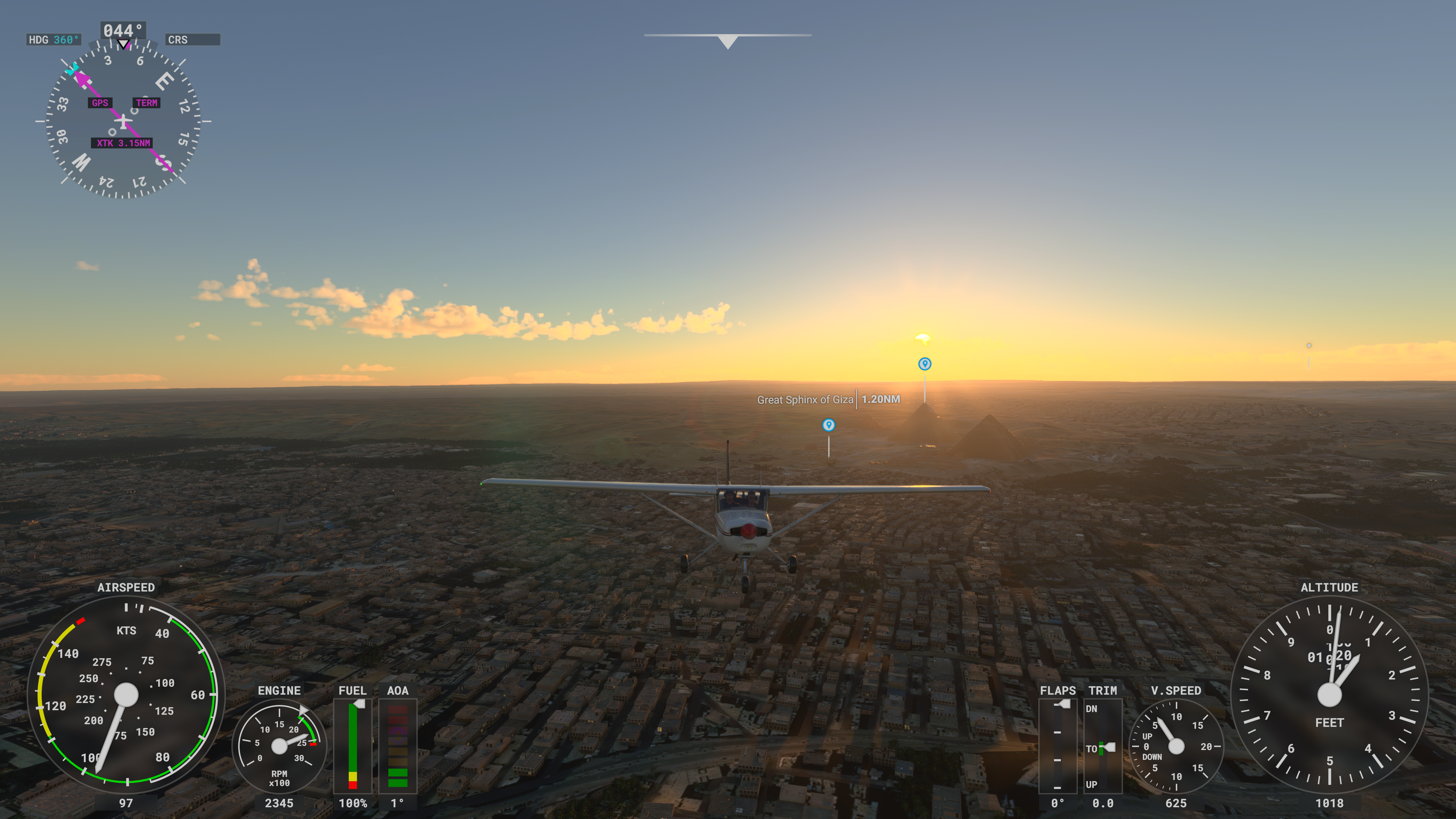 Turning the camera towards the sunrise that is bathing Giza right now.
Turning the camera towards the sunrise that is bathing Giza right now.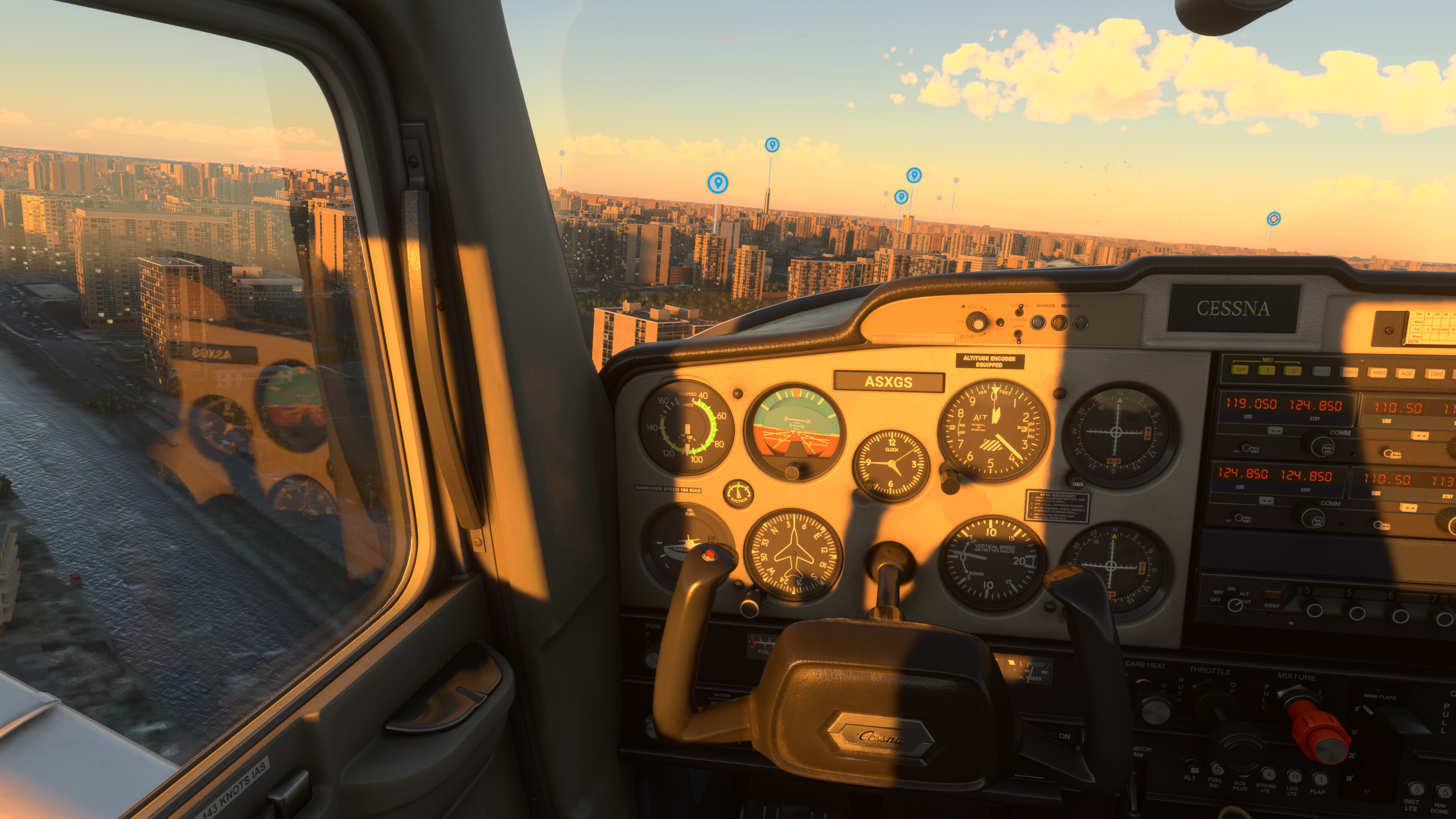 Handsome reflections on the window, along with high-res textures all over the cockpit and very nice water effects below.
Handsome reflections on the window, along with high-res textures all over the cockpit and very nice water effects below.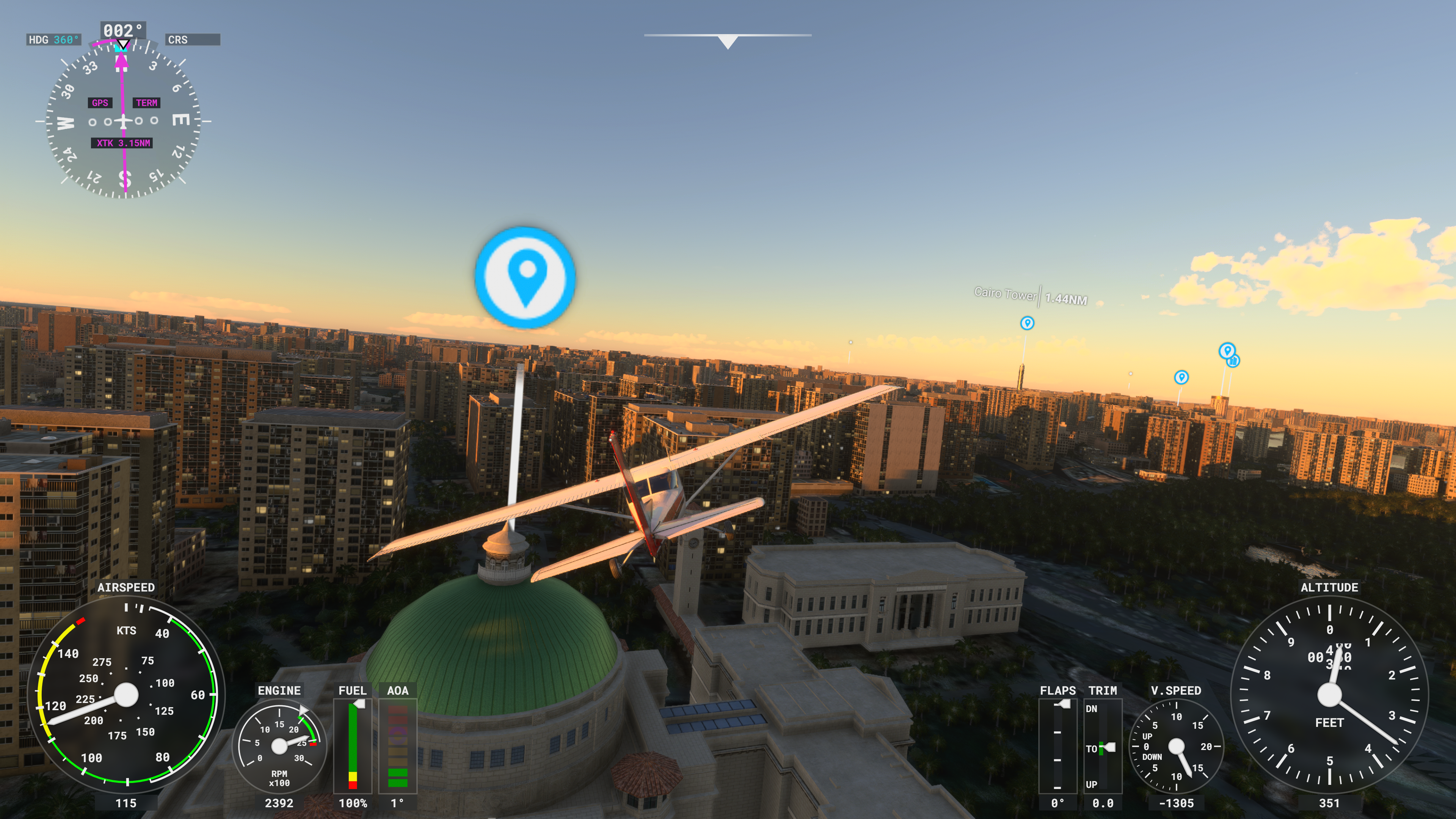 You can disable these landmark icons if you prefer.
You can disable these landmark icons if you prefer.
When I think of the history of game consoles, I think of flight simulators.
Nintendo in particular has leveraged the "Pilotwings" name not once, not twice, but thrice to show off brand-new tech over various generations. I have long loved that approach. Pilotwings games err on the side of minimal challenge and maximum relaxation, arguably to let players calmly absorb the newest 3D-rendering tricks of each era.
I think about that strategy now because Microsoft Flight Simulator is launching on Xbox Series X/S this week. Since it's roughly eight months out from those consoles' launches, it doesn't count as a "launch" game. But Microsoft Flight Simulator is honestly the first true "next-gen" first-party console game in Xbox's latest era. Part of that next-gen quality is because this game, unlike other first-party fare, has no "backwards compatibility" path to the older Xbox One family.
It doesn't take long to realize why. After a tremendous launch on PCs last year, MSFS has now emerged as a living room game with an emphasis on relaxed, Pilotwings-like trips across the entire globe. In good news, it sets a new bar for 3D rendering performance on consoles, and it stands head and shoulders above all other console games at this time. But its PC heritage lingers in the form of some clunkiness. Flight-sim novices—particularly those who claim the game as part of their Game Pass subscriptions—should brace themselves for control- and interface-related turbulence.
Getting up to speed—and that's a lot of knots
If you're unfamiliar with MSFS's latest incarnation, my report on its reveal nearly two years ago is a good starting point. Much of what I said then (and what I said in a follow-up look at its 2020 beta) is still true. MSFS 2020 combines Bing's world-mapping data, Azure's data-processing centers, and some fantastic rendering engine technology to open the entire Earth to unfettered flight. That dev team, lead by the French studio Asobo, employs a lot of clever procedural generation to turn blurry map data into convincing cities, forests, oceans, and valleys for you to fly over.
Since the game's launch on PC, Asobo has been vocal and transparent about its efforts to spruce up and fine-tune its plane physics simulations, which account for air pressure, heat, and other weather variables. The results have been generally well received by the flight-sim community, and the trade-off for so much beauty and world detail by default is milder physics realism and fewer customization options than rival PC flight sims like X-Plane 11 or Prepar3D. Still, this version of MSFS is Microsoft's most competent flyer yet.
One point of community contention, however, is MSFS's notoriously uneven performance across a variety of PCs. Performance hitches and stutters are more often the rule rather than the exception, while massive download requirements for various patches haven't necessarily curried favor with PC players. MS and Asobo have promised PC version optimization as far back as the game's July 2020 beta period, yet to this day, the PC version pulls powerful CPUs and GPUs to their knees at even "mid-high" settings, let alone with unnecessarily maxed graphics sliders.
In terms of CPU optimization, we're now in "better late than never" territory, because the Xbox Series X/S ports are clearly running on an updated, focused version of the engine. Holy cow, are the results tremendous.
The prettiest Xbox Series X/S game yet, by far
 Xbox Series X: Approaching Christ the Redeemer in Rio de Janeiro.
Xbox Series X: Approaching Christ the Redeemer in Rio de Janeiro. Xbox Series S: Approaching Christ the Redeemer in Rio de Janeiro. The cloud-rendering approach is different, though in many scenarios, the perceptible difference doesn't necessarily mean it's worse.
Xbox Series S: Approaching Christ the Redeemer in Rio de Janeiro. The cloud-rendering approach is different, though in many scenarios, the perceptible difference doesn't necessarily mean it's worse.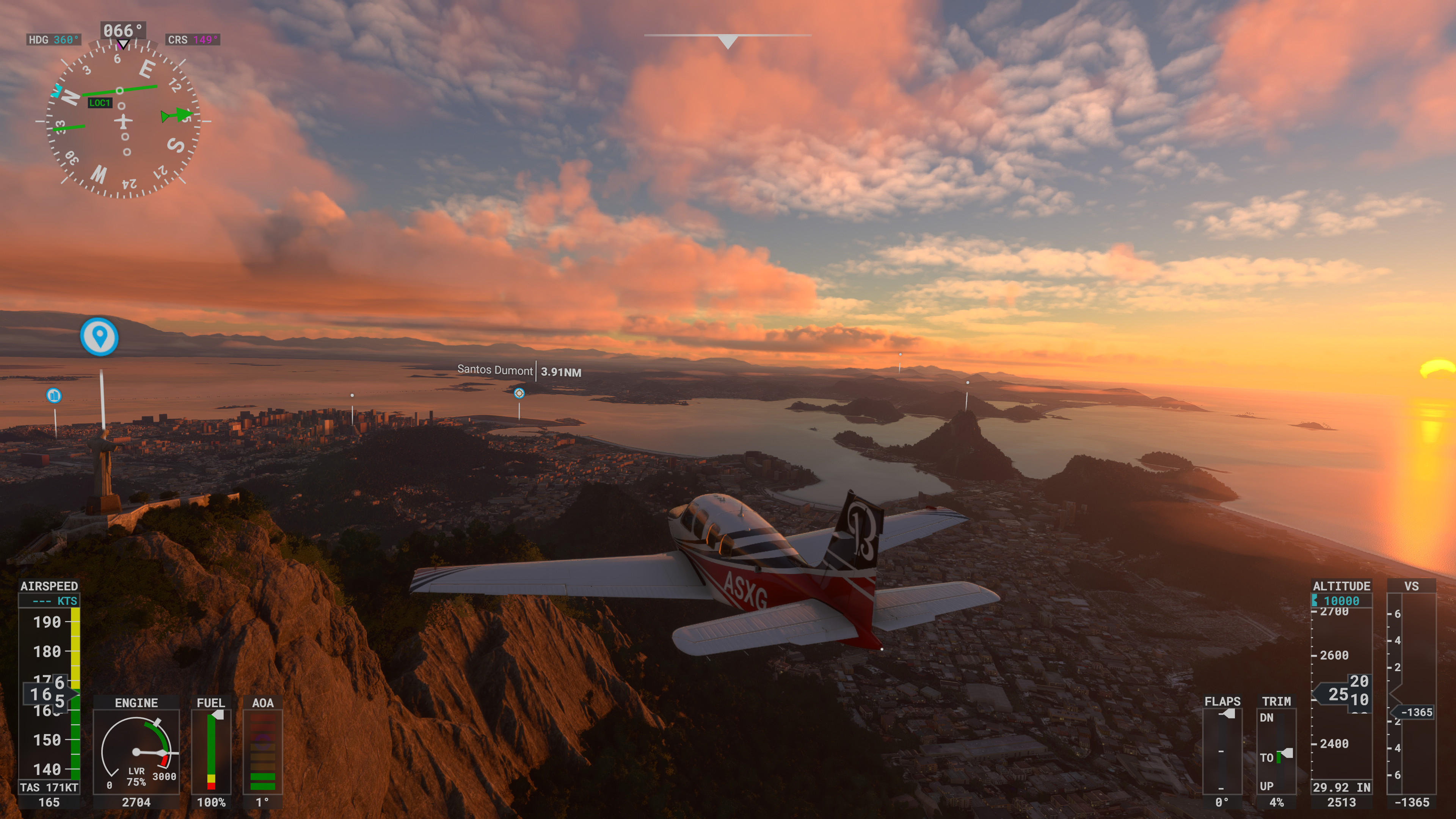 Xbox Series X: Passing Christ the Redeemer in Rio de Janeiro.
Xbox Series X: Passing Christ the Redeemer in Rio de Janeiro. Xbox Series S: Passing Christ the Redeemer in Rio de Janeiro. The lighting is different due to the angle (and HDR tone-mapping, which all platforms are contending with), while the lower resolution and culled-back detail in the distance are because of the weaker platform.
Xbox Series S: Passing Christ the Redeemer in Rio de Janeiro. The lighting is different due to the angle (and HDR tone-mapping, which all platforms are contending with), while the lower resolution and culled-back detail in the distance are because of the weaker platform. Xbox Series X: Flying over Manhattan.
Xbox Series X: Flying over Manhattan. Xbox Series S: Flying over Manhattan. The LoD slider is severe here, culling more distant buildings than on Series X. This is also a good example of clouds proving less fluffy on Series S.
Xbox Series S: Flying over Manhattan. The LoD slider is severe here, culling more distant buildings than on Series X. This is also a good example of clouds proving less fluffy on Series S.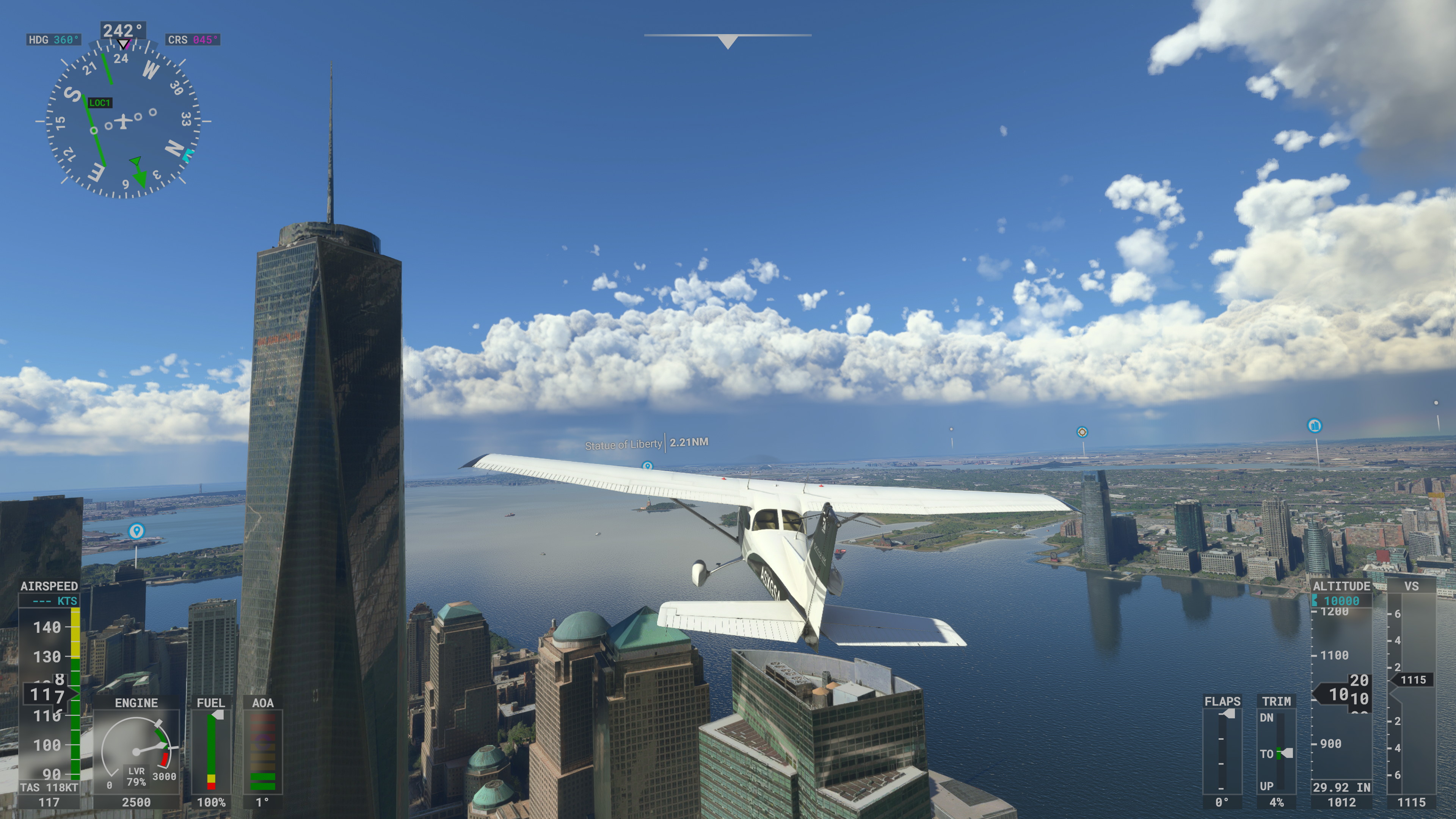 Xbox Series X: Flying past Conde Nast headquarters in 1 World Trade Center.
Xbox Series X: Flying past Conde Nast headquarters in 1 World Trade Center.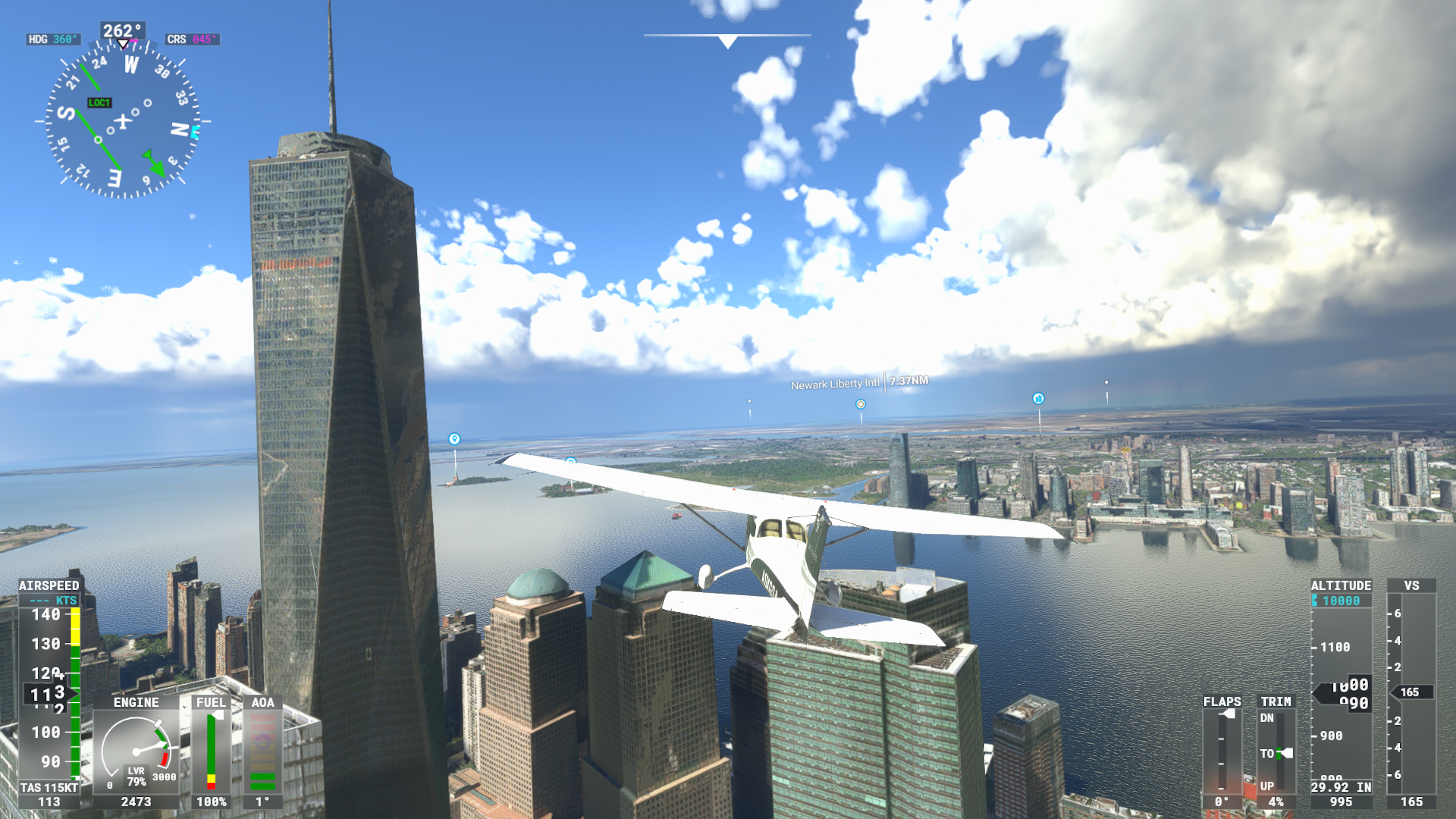 Xbox Series S: Flying past Conde Nast headquarters in 1 World Trade Center. Again, the LoD slider is more severe here for distant buildings.
Xbox Series S: Flying past Conde Nast headquarters in 1 World Trade Center. Again, the LoD slider is more severe here for distant buildings.
Both consoles can now nearly lock to 30 fps refreshes in most of the environments I've cherry-picked to test, all while pushing a resolution approaching 2160p on Series X and 1080p on Series S. Exact pixel-count measurements of this article's captures point to a full-pixel resolution on both consoles, perhaps aided by a very efficient temporal anti-aliasing (TAA) solution to bring lower pixel counts to a crisper final maximum. The results are jaw-dropping. They include some of the most detail-rich 3D environments I've ever seen in a real-time video game, all humming along with gorgeously lit, particle-filled clouds—and without apparent sacrifices to pixel fidelity or frame rate.
Getting to this impressive result includes a few significant caveats. While these don't necessarily break the game's visual sheen, they do point to Asobo's clever engineering choices.
The most obvious is a rendering issue that emerges nearly every time MSFS console players nudge a manual camera control. If you're viewing your mid-air surroundings within a cockpit, and thus have flight equipment obscuring some of your view of the world below, you might still get a 30 fps refresh when you nudge the camera. Doing the same from an exterior point of view (as triggered by the Xbox gamepad's "options" button), on the other hand, always temporarily drags into 30 fps territory on both Series X/S. Stop changing the camera angle, and you're back to something near 30 fps, even as you steer your plane dramatically. This implies that something in the renderer flips on and off when a manual camera adjustment is engaged (which doesn't happen in the current PC version).Certain crowded cityscapes, particularly Manhattan, can suffer from this sub-30 fps issue by steering aggressively while in an exterior camera angle. These moments are by no means game-breakers, but they're a reminder that MSFS's massive landscapes can take their toll in select situations.
Upgrades, downgrades compared to PC
Additionally, depending on the locale a player flies over, various graphics sliders appear to be in play to keep MSFS performative on Series X/S. It's hard to estimate exactly what PC-equivalent "preset" the console version of MSFS uses, since some details are slightly lower on console, while others are far superior.
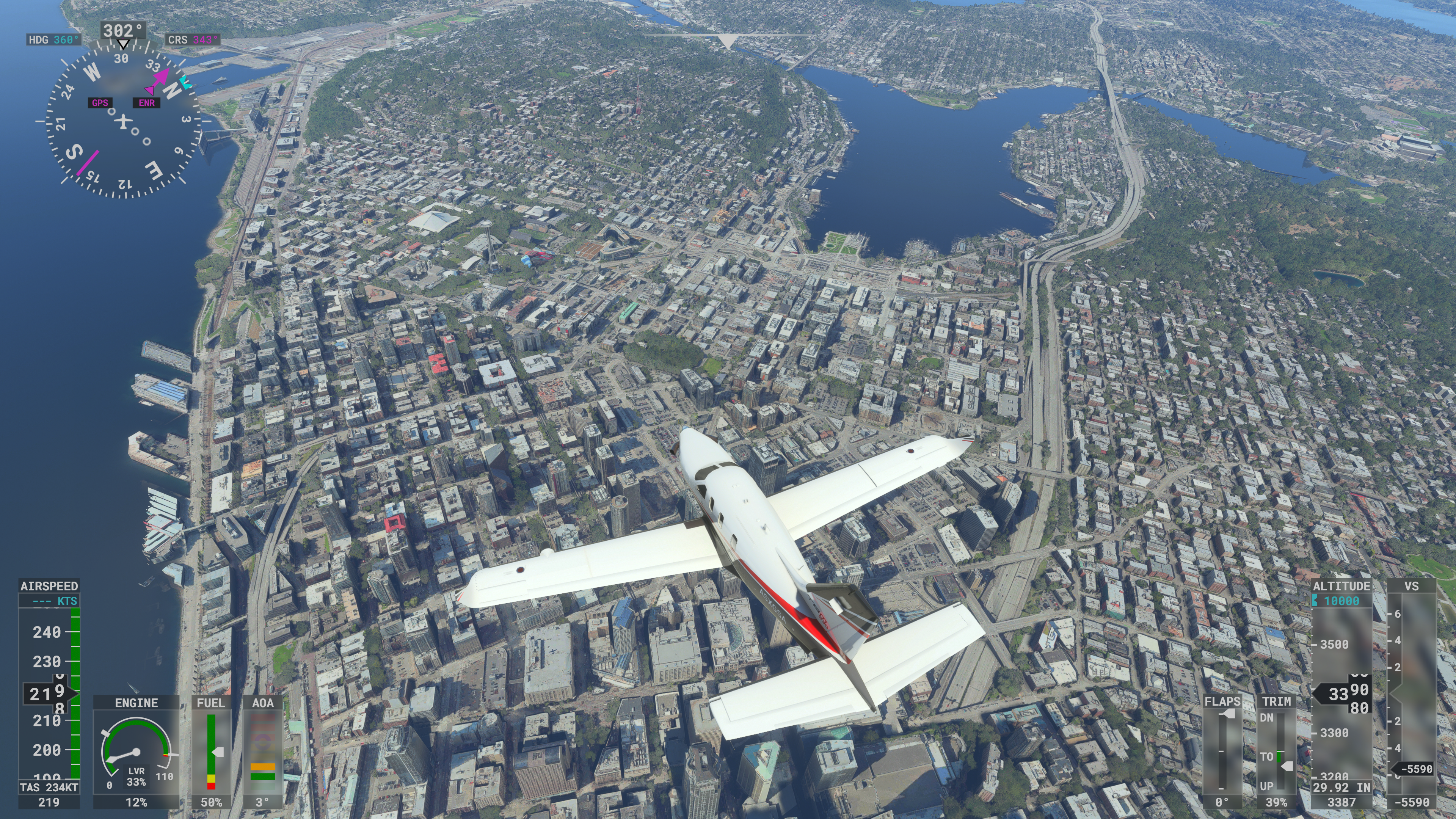 Xbox Series X: Flying towards Seattle's Space Needle.
Xbox Series X: Flying towards Seattle's Space Needle.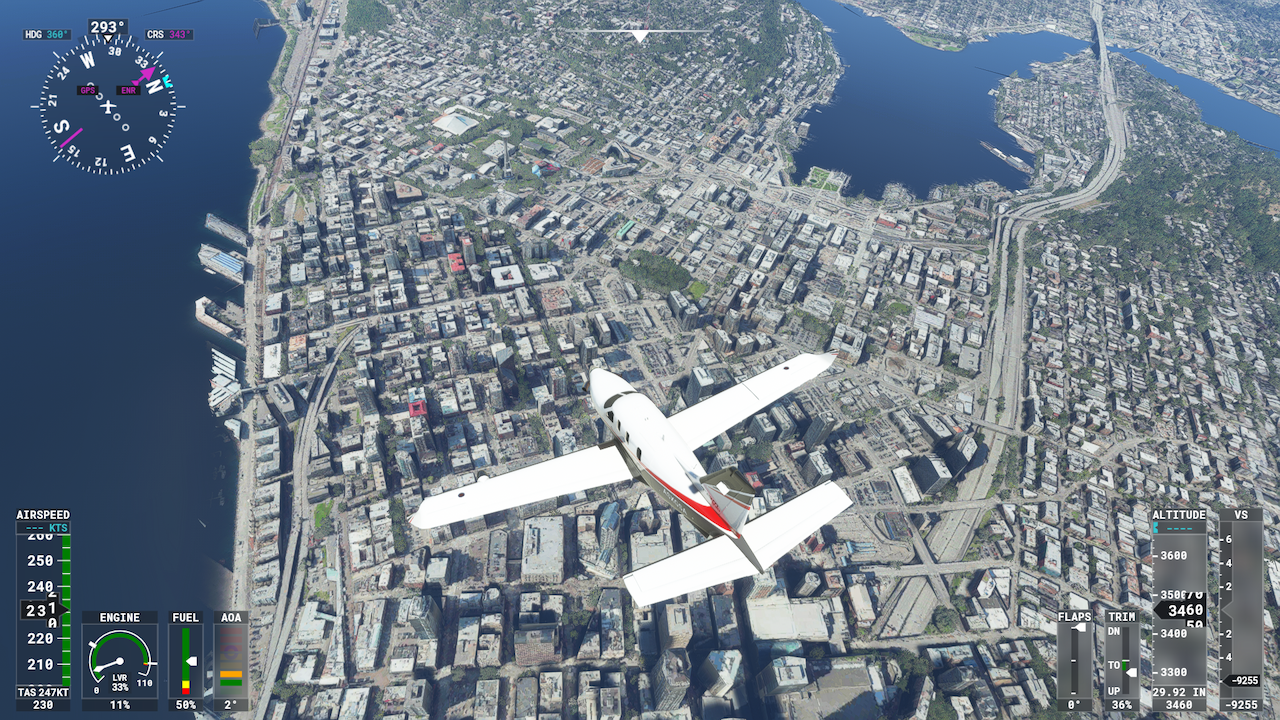 Xbox Series S: Flying towards Seattle's Space Needle.
Xbox Series S: Flying towards Seattle's Space Needle.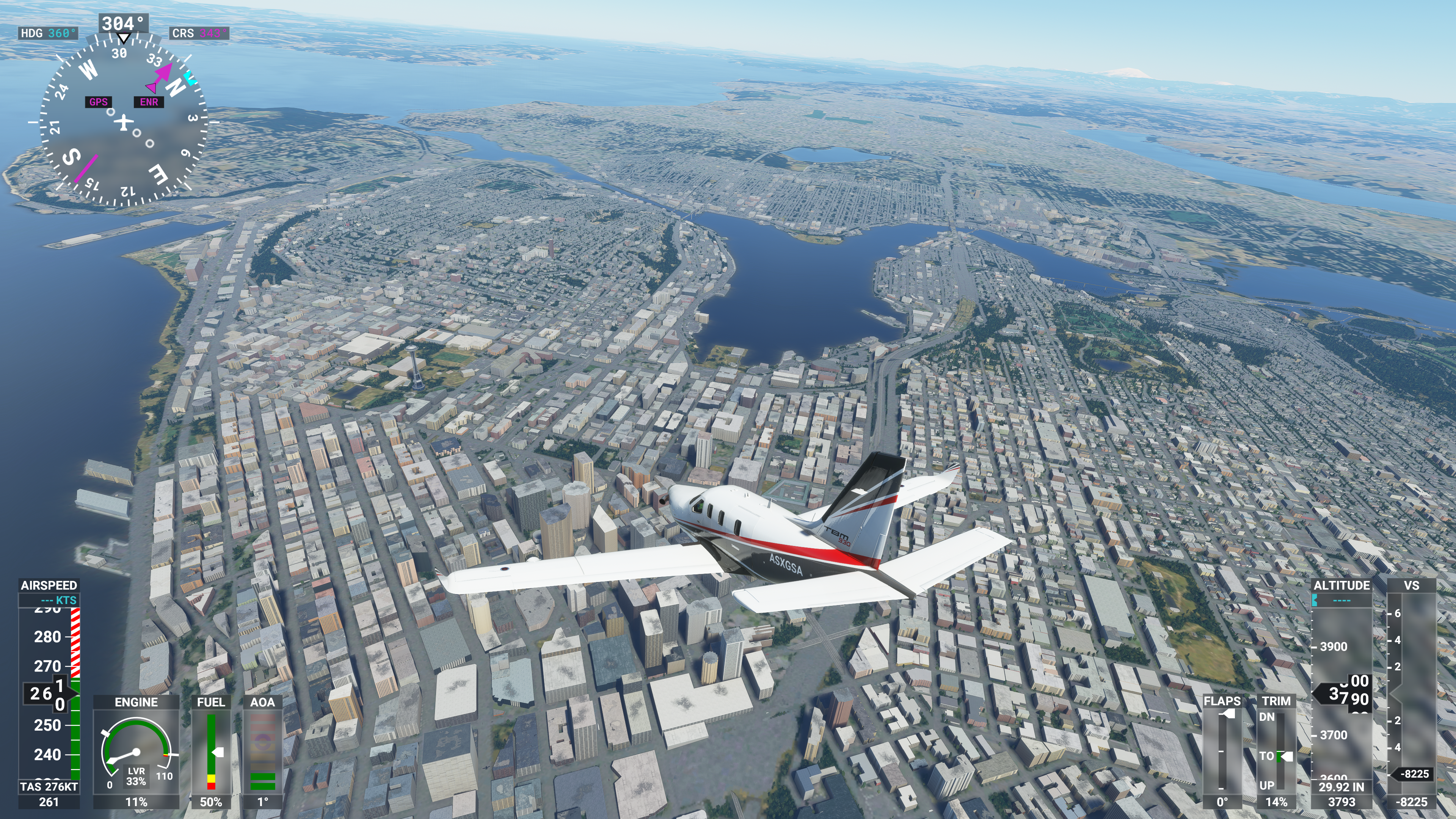 PC version, "high-end" preset: Flying towards Seattle's Space Needle. Notice the decidedly less detailed buildings than the newer console versions.
PC version, "high-end" preset: Flying towards Seattle's Space Needle. Notice the decidedly less detailed buildings than the newer console versions.
The most impressive upgrade from the PC version is an across-the-board boost to texture and building detail in certain populated cities, as seen above. While virtually flying over my hometown of Seattle at the "high-end" PC setting, I see a pretty massive number of different-looking buildings, albeit not with a ton of differentiating detail save the city's most unique architecture (particularly the Space Needle). Dive to the same spot on the Series X and Series S versions, on the other hand, and it's a different story. This specific boost to city detail may very well find its way to PC presets in the near future, but it's not there yet.
When we take MSFS tests out of the city and into the country, on the other hand, Series X and S are forced to downscale the complexity and texture detail applied to distant, massive landforms, especially mountains and hills. That can be seen in the gallery below, with Series S bringing down its detail further—and additionally pulling back on how many light bounces its particle-filled clouds can parse. That affects the painterly sunset effect that this "landing challenge" preset comes with.
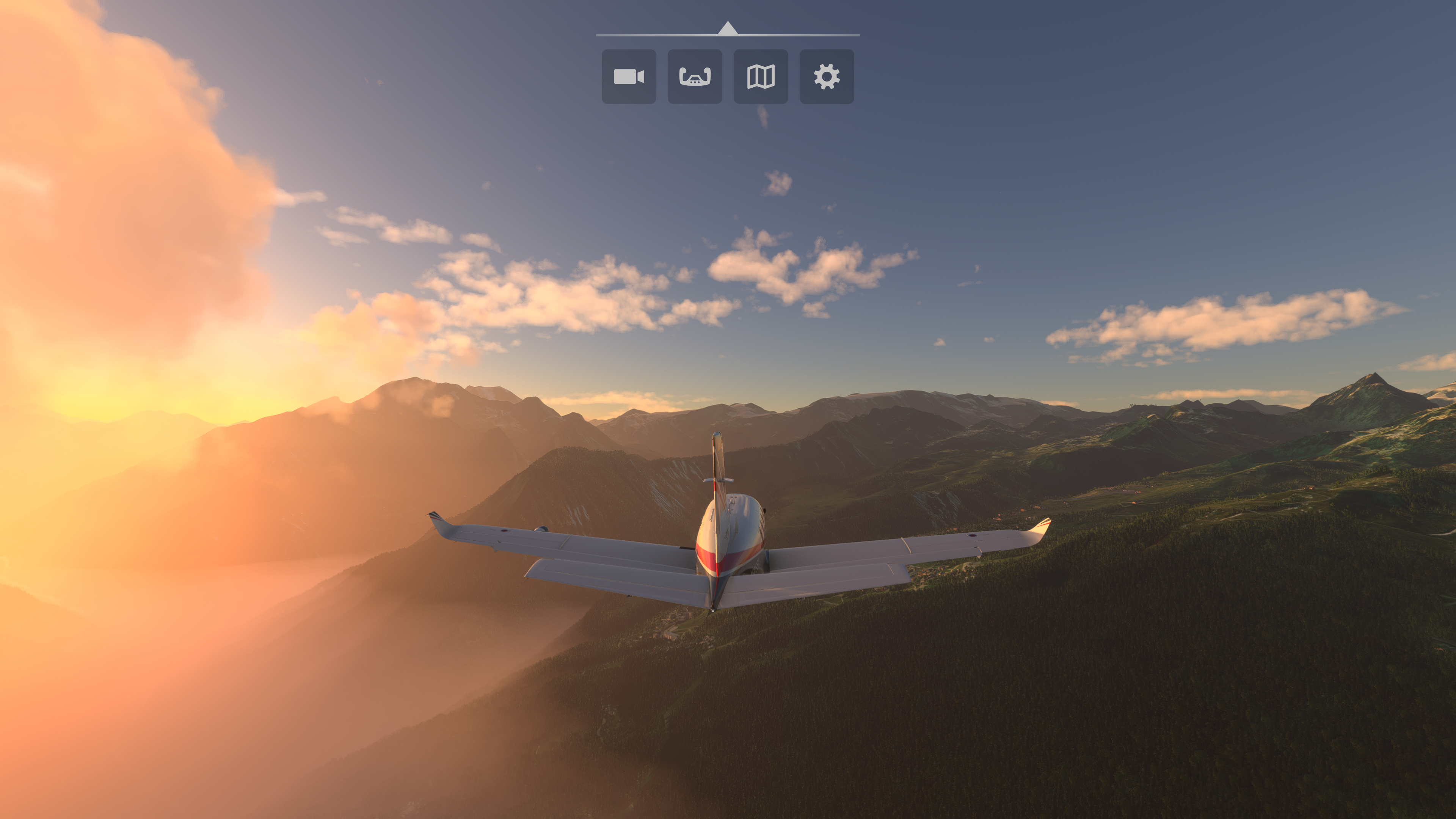 Xbox Series X: Courchevel landing challenge.
Xbox Series X: Courchevel landing challenge.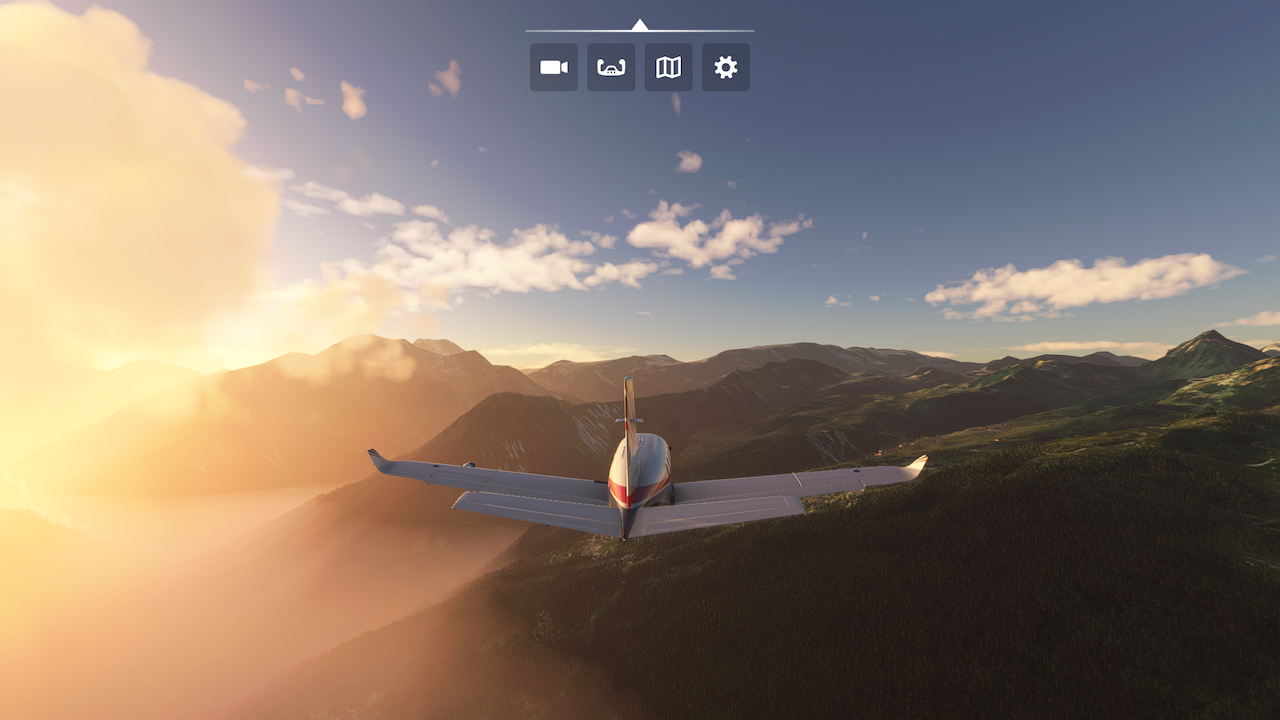 Xbox Series S: Courchevel landing challenge.
Xbox Series S: Courchevel landing challenge.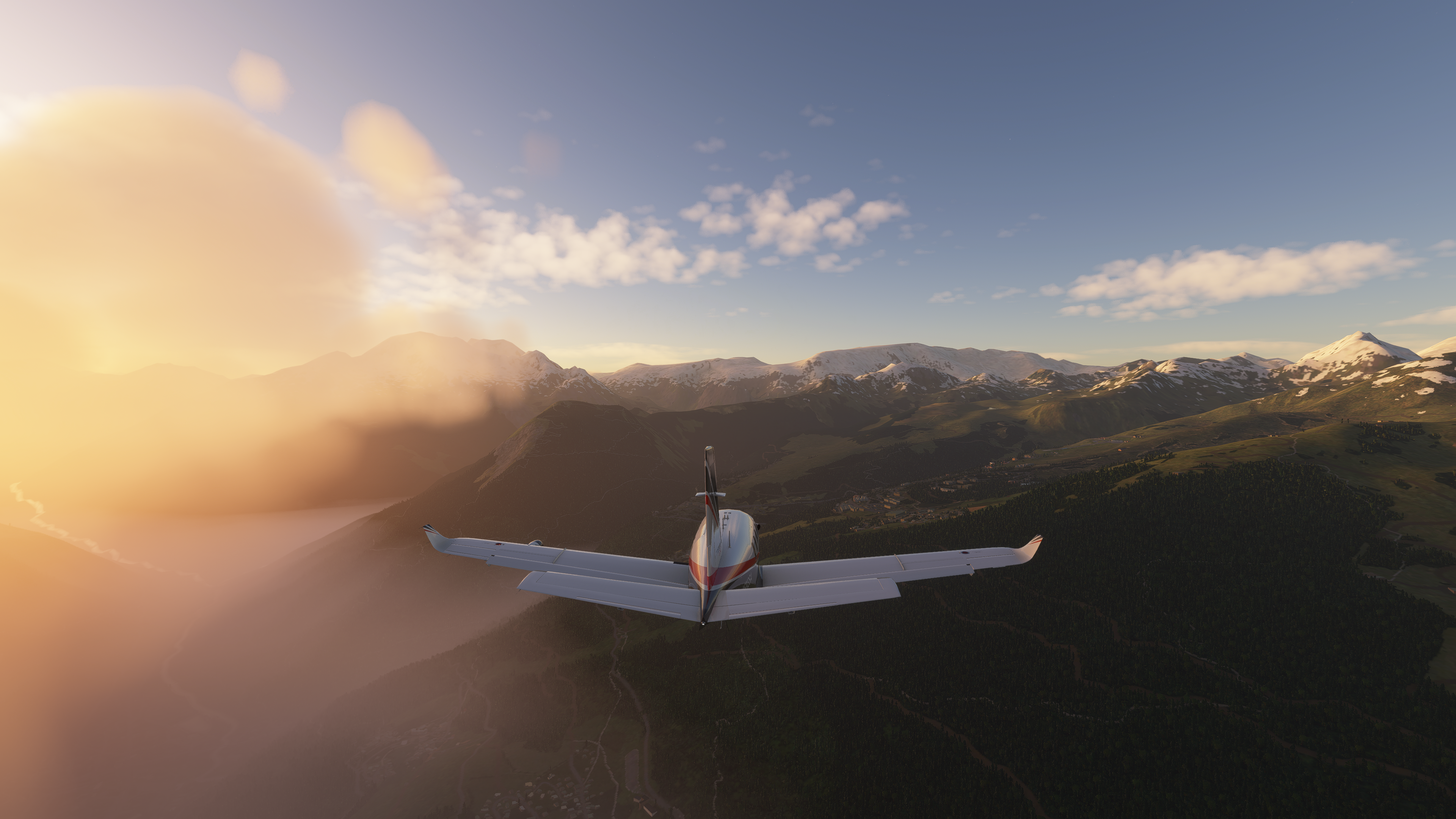 PC, "high-end" preset: Courchevel landing challenge. Notice the richer detail in the distance.
PC, "high-end" preset: Courchevel landing challenge. Notice the richer detail in the distance. Xbox Series X: Courchevel landing challenge.
Xbox Series X: Courchevel landing challenge.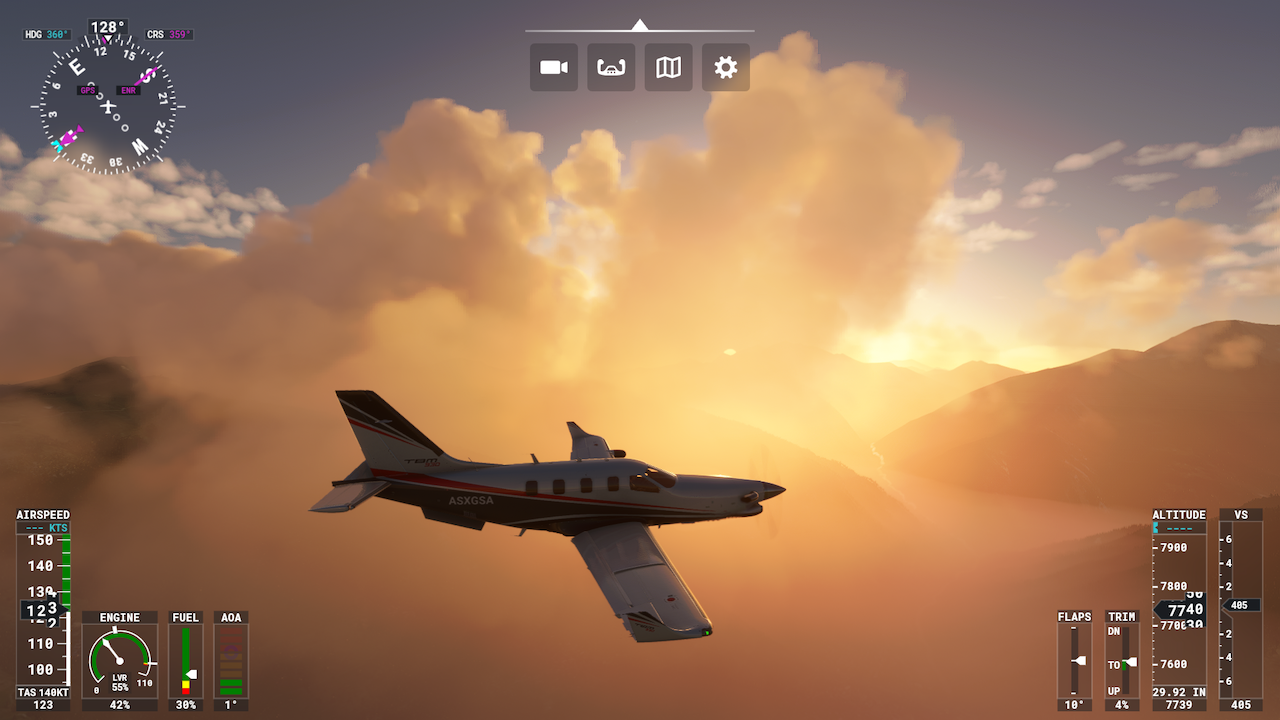 Xbox Series S: Courchevel landing challenge. This is an example of particle-filled clouds picking up less nearby light than on Series X, even though they're still quite attractive.
Xbox Series S: Courchevel landing challenge. This is an example of particle-filled clouds picking up less nearby light than on Series X, even though they're still quite attractive. PC, "high-end" preset: Courchevel landing challenge. Admittedly fluffier clouds in the distance.
PC, "high-end" preset: Courchevel landing challenge. Admittedly fluffier clouds in the distance.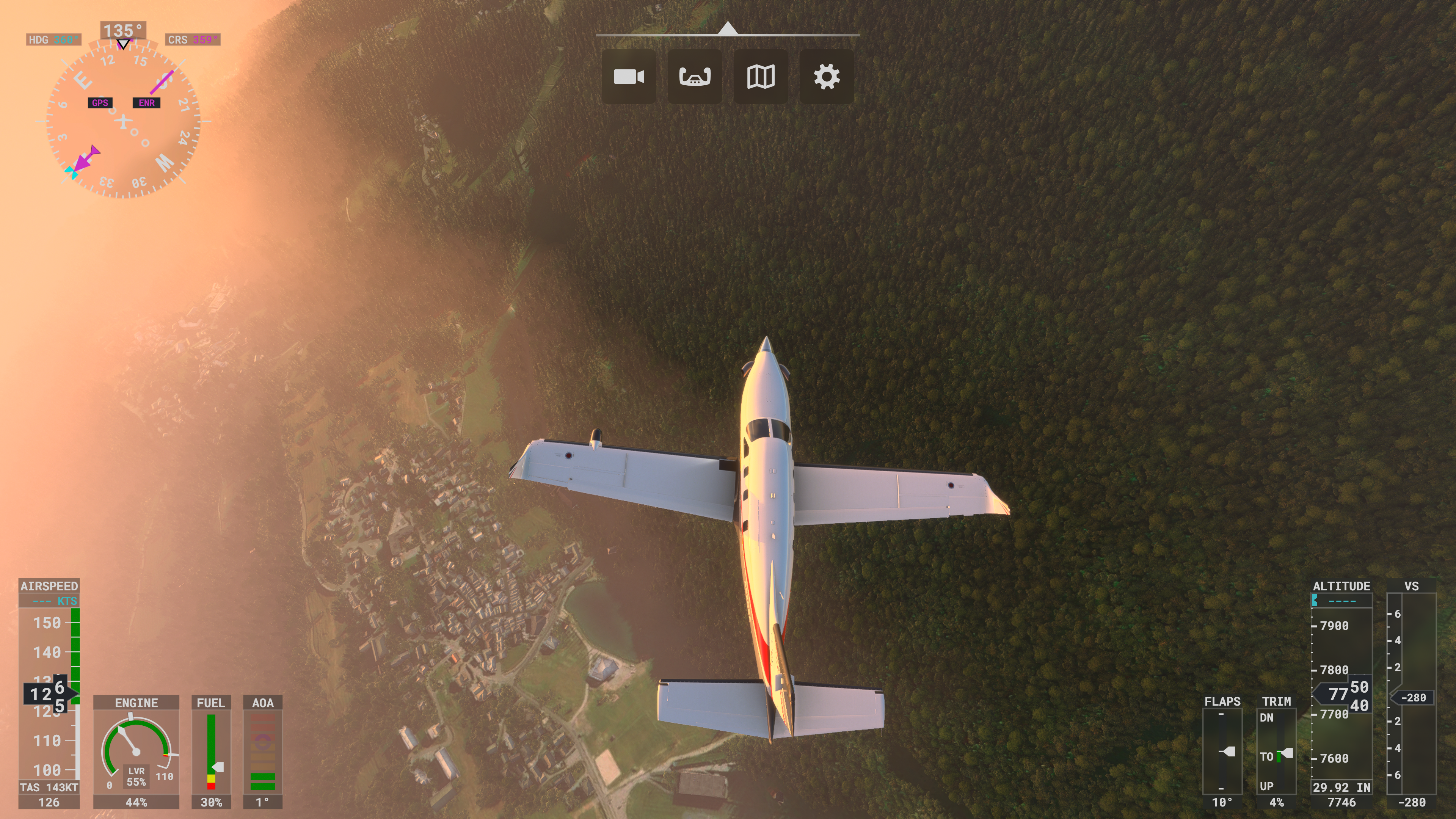 Xbox Series X: Courchevel landing challenge.
Xbox Series X: Courchevel landing challenge. Xbox Series S: Courchevel landing challenge.
Xbox Series S: Courchevel landing challenge.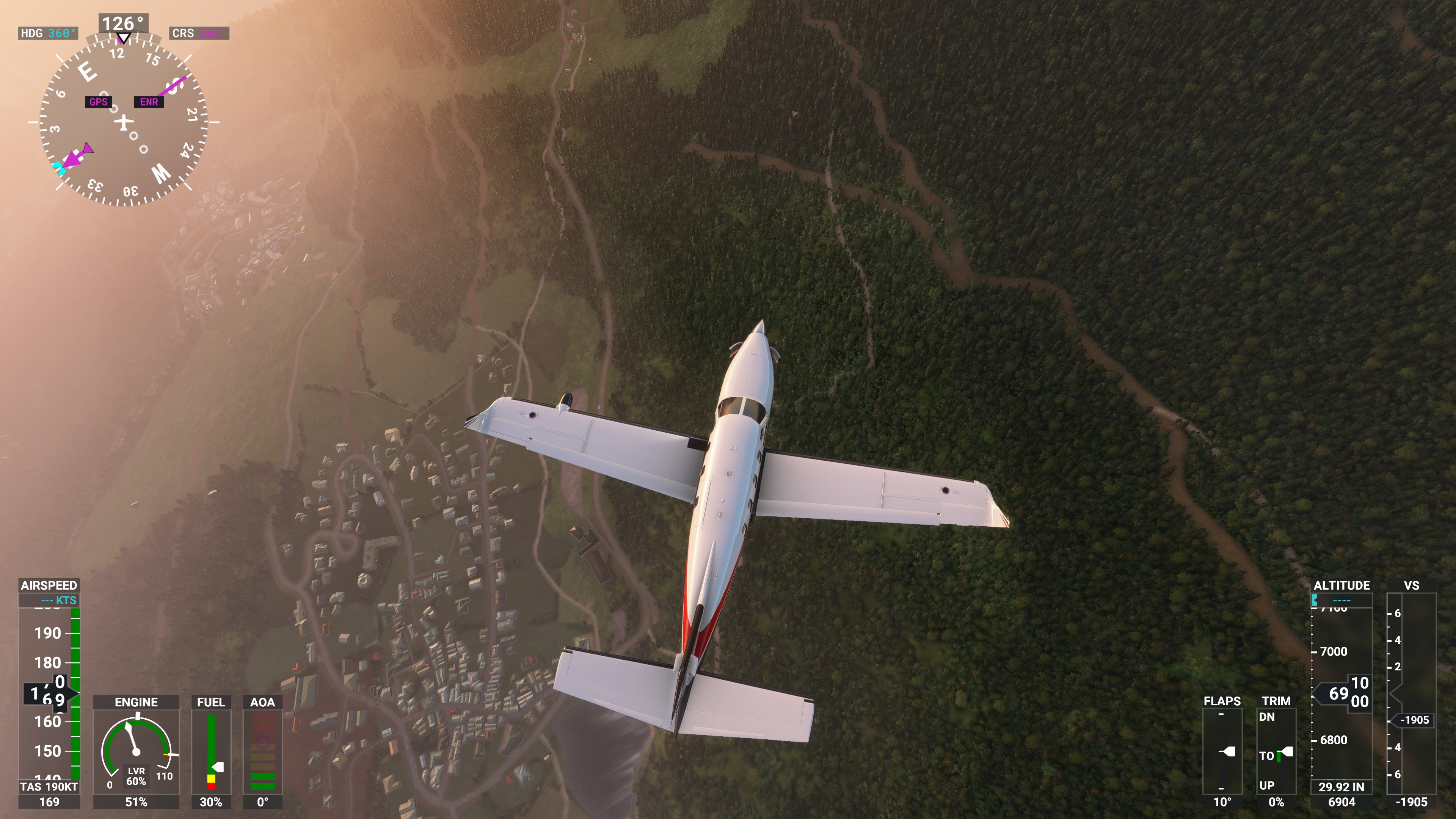 PC, "high-end" preset: Courchevel landing challenge.
PC, "high-end" preset: Courchevel landing challenge.
Neither of these comparison galleries does a great job reflecting the level-of-detail (LoD) slider inherent in each version. The PC build, at "top-end" settings, draws more building and landscape detail at a further distance from the camera than either Xbox Series console. Ultimately, all MSFS versions include some form of object pop-in, since we're still not at the computationally infinite power that's arguably needed to make every house and tree appear from the camera's lens all the way to a virtual world's horizon. (For context on this, fly a jet in Grand Theft Auto V at max visual settings on PC, then examine how the world handles distant elements' pop-in. You'll see that MSFS is far more efficient than an average open world video game.)
Having put the Series X and Series S versions through flights across identical zones, both among Asobo's series of Discovery locales and some randomly picked zones that I've previously tested on PC, I'm confident in saying that Series S ultimately doesn't hold up as a "beautiful anywhere" flight sim the way its Series X sibling does. It's still a performative beast, in terms of offering global, 1080p flight gorgeousness by default. But its handling of city-specific detail, distant geometry, and up-close particle systems, along with its more aggressive LoD slider, are solid proof that Series S costs $200 less for a reason. It's not just a matter of lower resolution to get to "identical" performance.
MSFS's path to console isn't arcadey at all
In terms of new, console-minded content, MSFS doesn't approach something like Pilotwings, let alone arcade flight games like Ace Combat or Crimson Skies. Think of this game as boring, grown-up business—there's not much here for little kids to do. (Not even old issues of Highlights Magazine? C'mon, Asobo.)
Would you like to take off from any runway in the world, fly as you see fit, and then eventually land on any runway in the world (or, with the right plane, a patch of grass or open body of water)? Go right ahead. If you're uneasy about the takeoff process, start a flight from mid-air, either via the handy "Discovery flights" menu or by picking a landmark in the game's full-globe map, and fly around until you'd rather quit outright than bother trying to land.
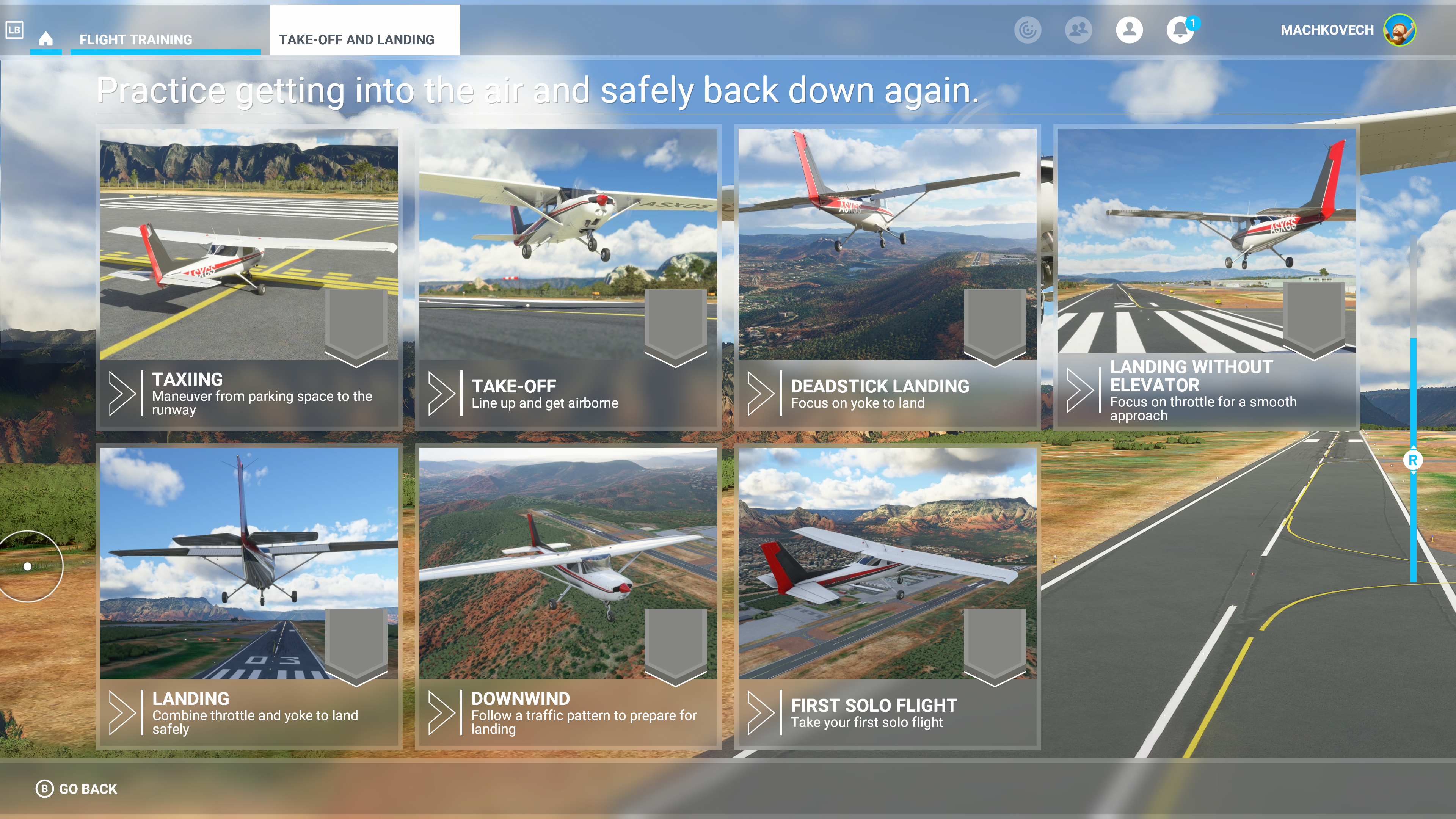 One of the tutorial sub-categories.
One of the tutorial sub-categories. Step-by-step info on what each tutorial contains. Many of these are lifted wholesale from the existing PC version.
Step-by-step info on what each tutorial contains. Many of these are lifted wholesale from the existing PC version. Use an Xbox to become an Airbus pilot! Well, not exactly.
Use an Xbox to become an Airbus pilot! Well, not exactly.
That's pretty much all you do in MSFS, even though those basic activities are spruced up with a few modes lifted from the PC version. "Landing challenges" fast forward you to the final descent towards a tricky runway somewhere on our planet, and you get roughly 60-180 seconds to adjust your speed, aim your craft, and land as smoothly and quickly as possible. "Bush trips" ask you to repeatedly take off, land, refill your gas, and repeat over the course of a long, scenic journey. And the game's "flight school" has been expanded with more tutorials about the basics of flight, and these largely resemble the basics you might be taught while learning to pilot a real-world Cessna. (One tutorial focuses on massive airliners, but it's painfully superficial. Don't expect to get up to Boeing or Airbus proficiency with that one.)
I'm bummed that Asobo didn't add arcade-like challenge options as part of the series' first console version. I understand not adding a fully fledged "adventure" or "quest" mode, and I appreciate the game's scenic series of Discovery flights—especially since they can be paired with a bunch of "flight assist" toggles for anyone more interested in gorgeous visuals than they are in accurate flight modeling. But why not let players fly through some mid-air rings, Star Fox-style, in a score challenge? What about single-player "time trial" races where players must take off, fly through a series of gates in order, then land (players could then compare results via a leaderboard)?
Conforming to the PC version means some weirdness
 The main menu looks much like that on PC.
The main menu looks much like that on PC.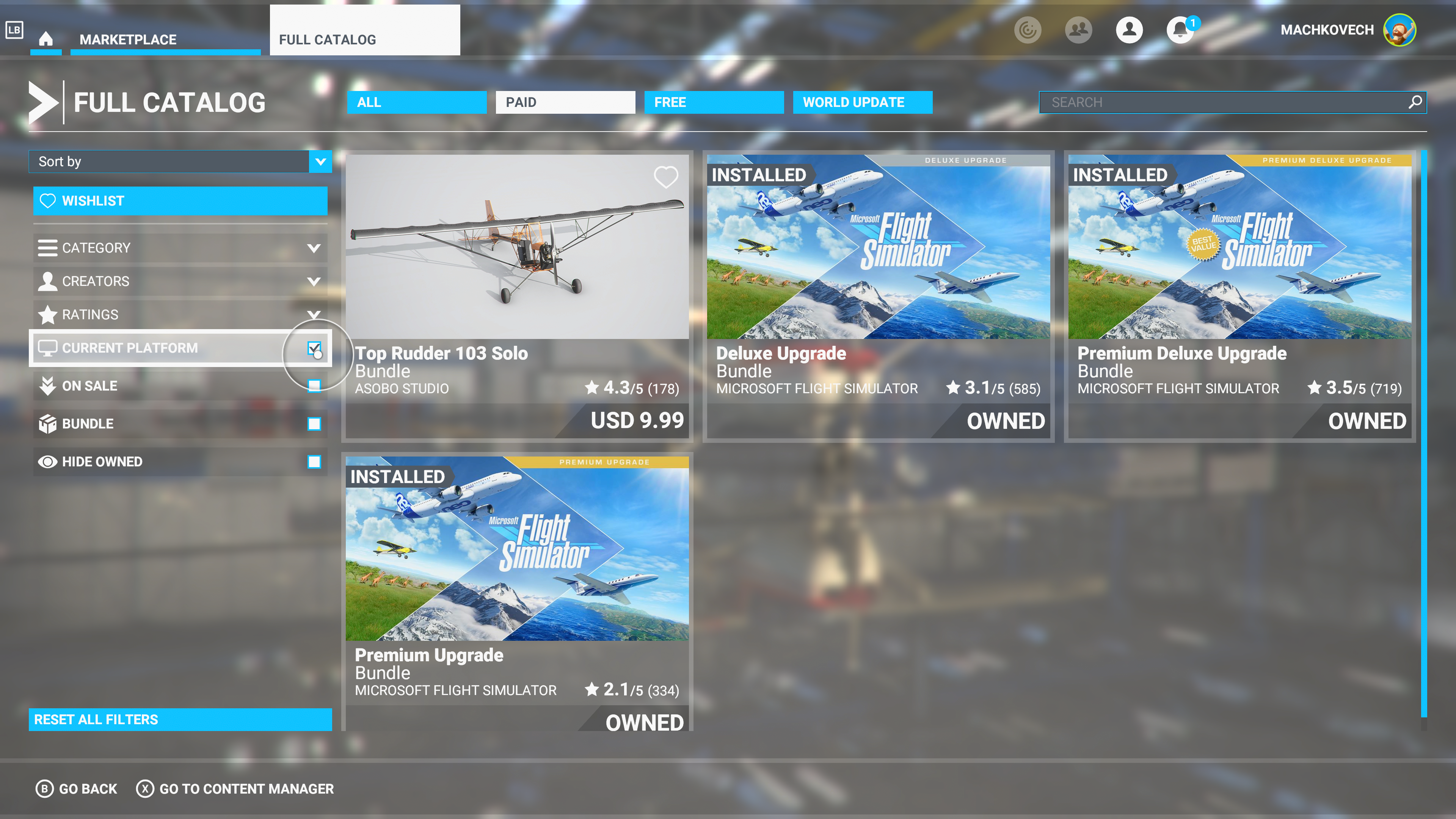 Wait, what's that "current platform" flag on the sidebar?
Wait, what's that "current platform" flag on the sidebar? Ahh, I see. Asobo has yet to clarify when any "PC-only" marketplace content from third-party sellers will arrive on Series X/S. I hope it's only a matter of a minor flag, as opposed to a serious restriction that will split the marketplaces.
Ahh, I see. Asobo has yet to clarify when any "PC-only" marketplace content from third-party sellers will arrive on Series X/S. I hope it's only a matter of a minor flag, as opposed to a serious restriction that will split the marketplaces.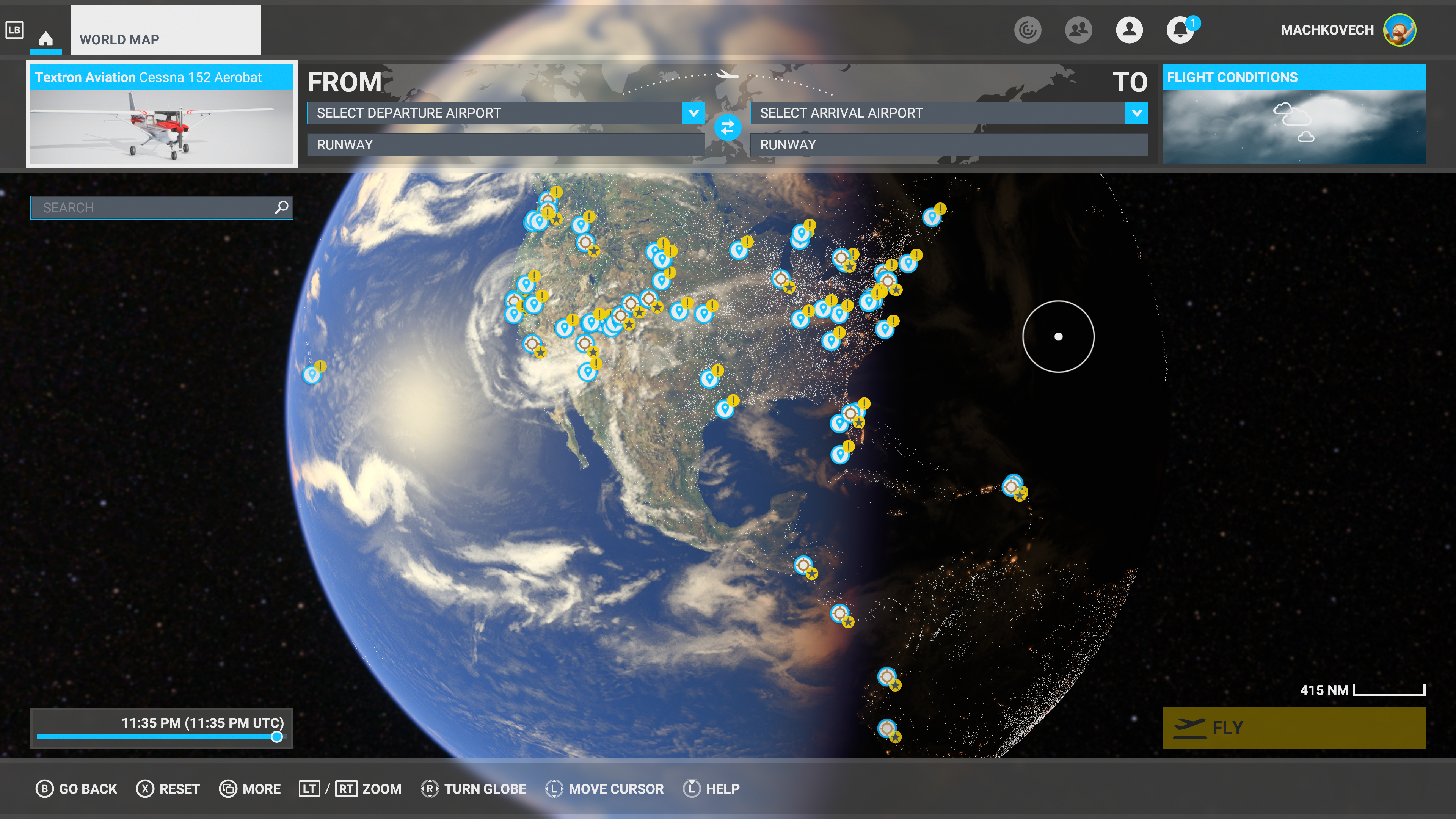 The console version of the game includes the same map interface.
The console version of the game includes the same map interface.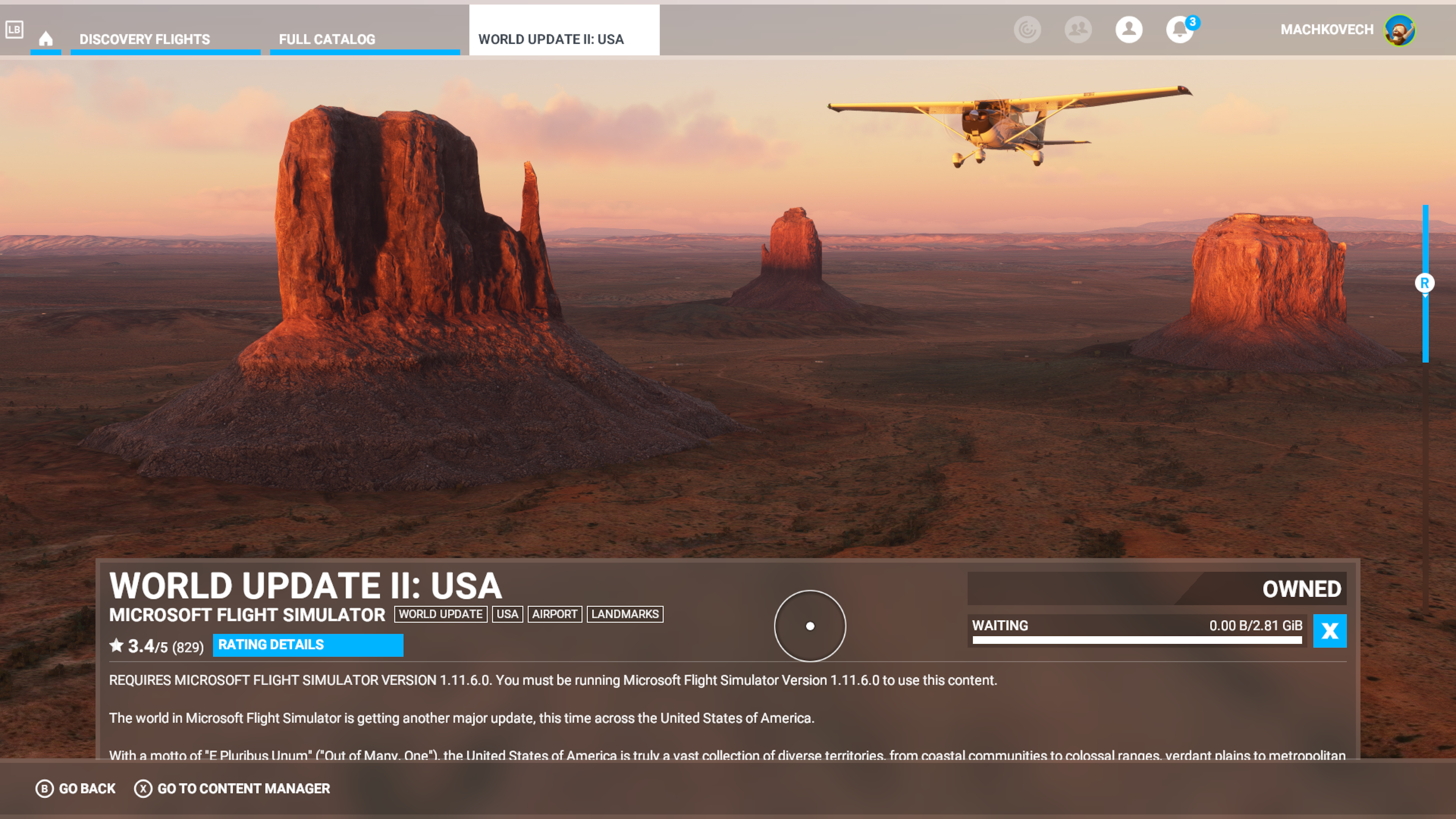 Every "world update" pack is free and adds a bunch of higher-fidelity details in various parts of the world.
Every "world update" pack is free and adds a bunch of higher-fidelity details in various parts of the world. Managing in-game downloads means jumping into a very PC-like interface.
Managing in-game downloads means jumping into a very PC-like interface.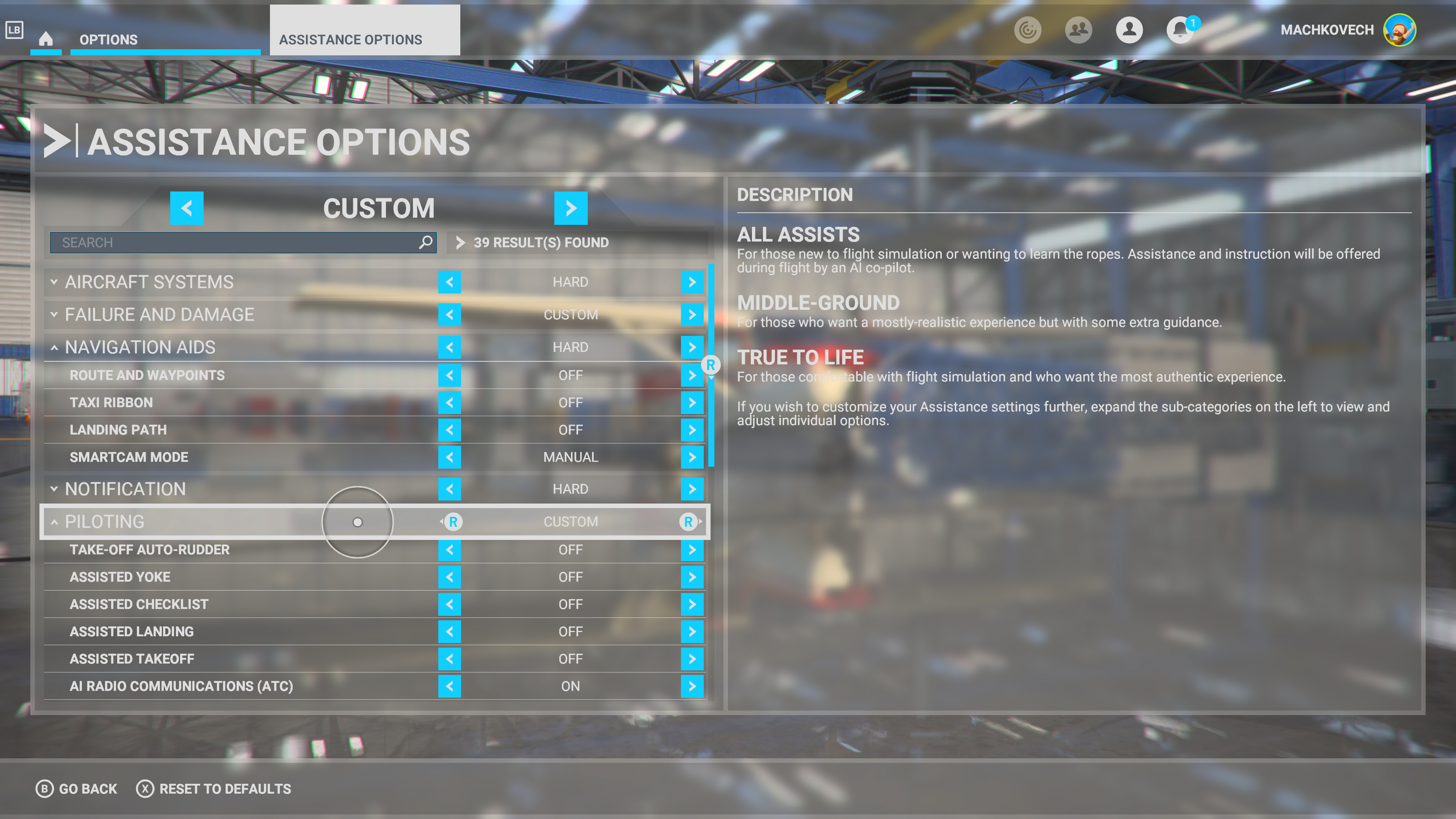 Enable or disable as many "assistance options" as you want.
Enable or disable as many "assistance options" as you want.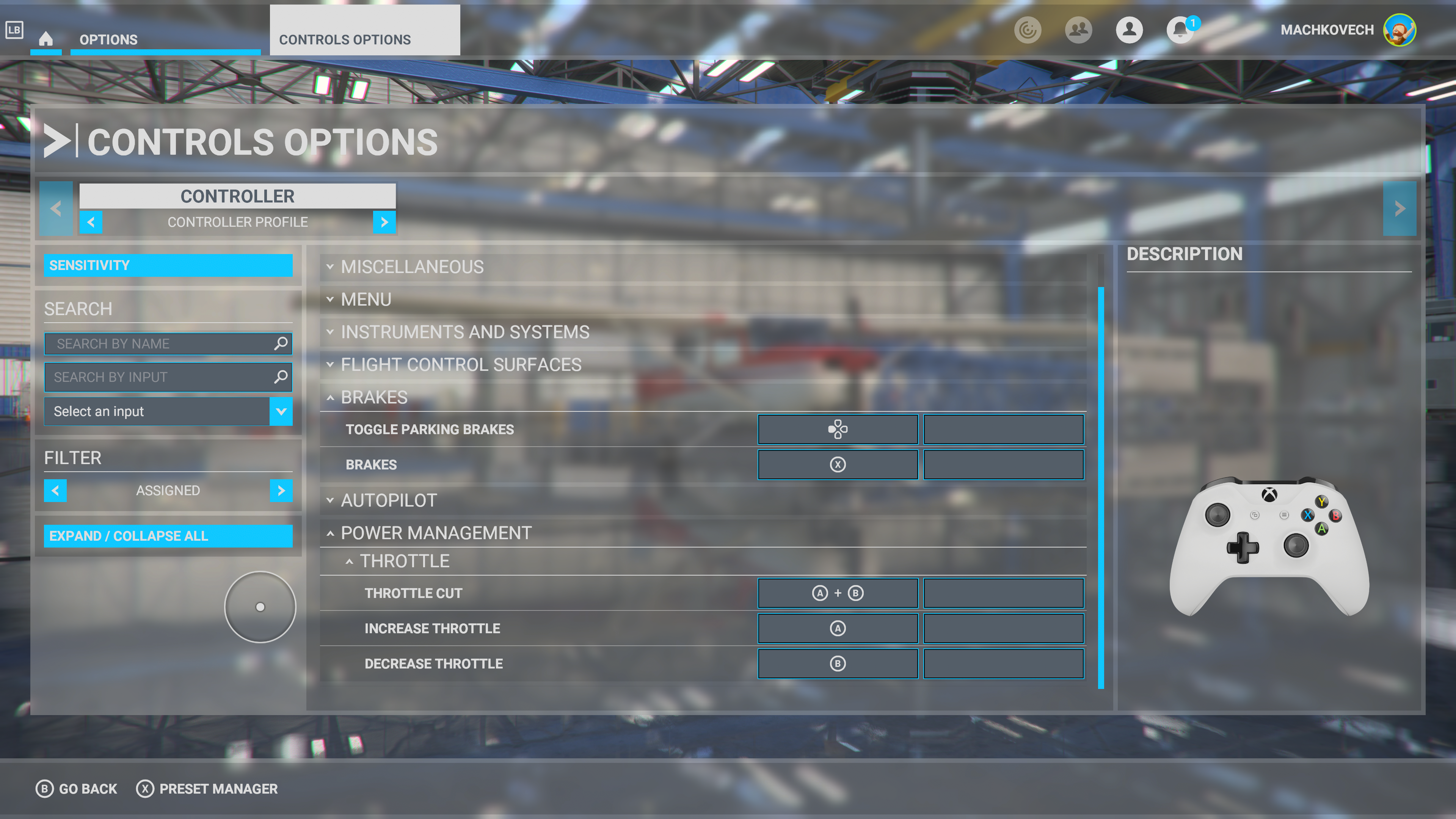 Use the "search" tab to find any command in the game and assign it as you see fit.
Use the "search" tab to find any command in the game and assign it as you see fit. If you don't plan to plug other peripherals in, you'll need to fiddle with "LB + RB" as a modifier to add even more custom button commands.
If you don't plan to plug other peripherals in, you'll need to fiddle with "LB + RB" as a modifier to add even more custom button commands. This is the only "visual" toggle on either console version of the game. For an interface that's otherwise so PC-like, I'm sort of shocked that they didn't add any toggles here beyond HDR.
This is the only "visual" toggle on either console version of the game. For an interface that's otherwise so PC-like, I'm sort of shocked that they didn't add any toggles here beyond HDR.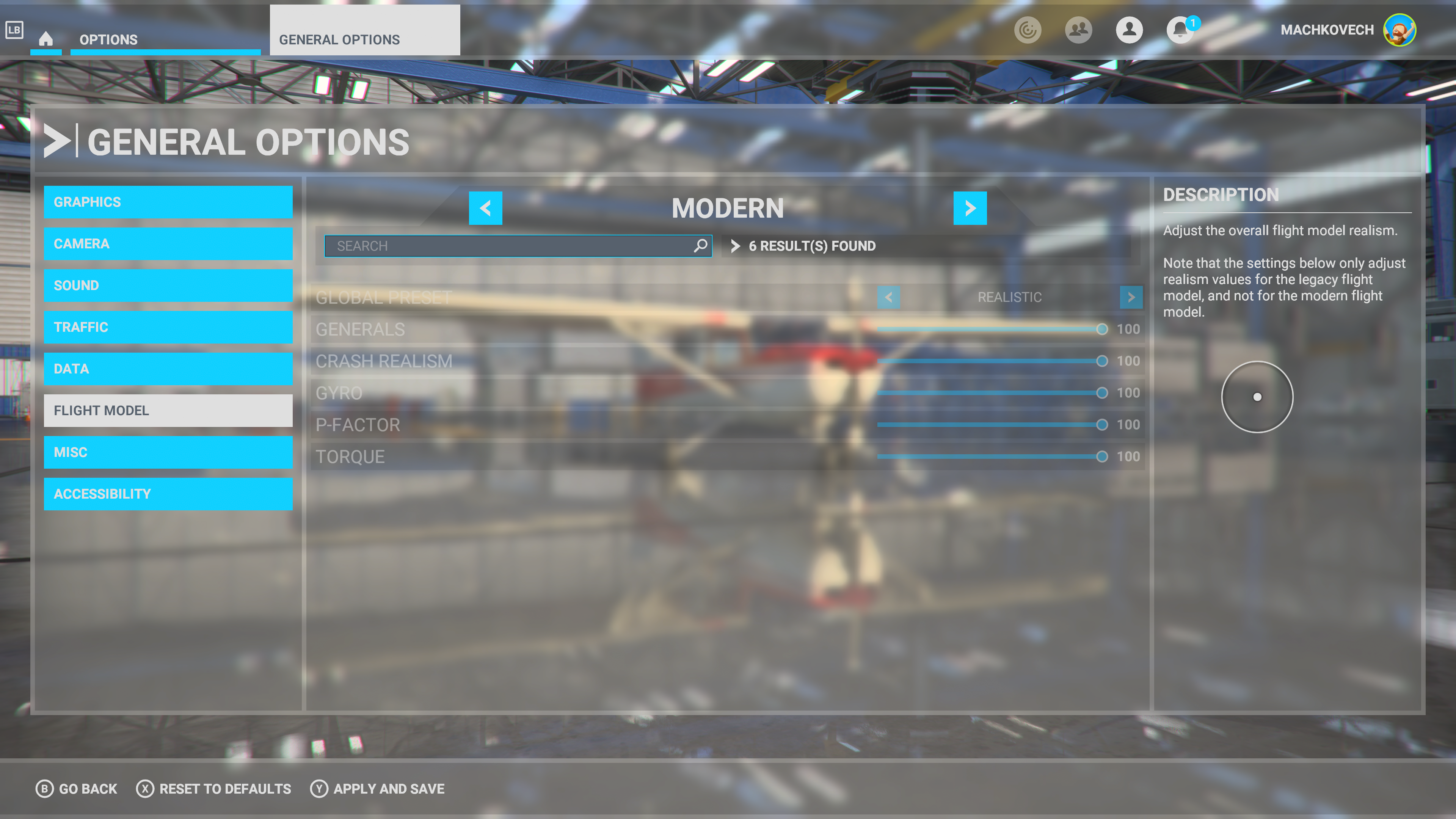 Just like on PC, you can revert various physics systems to better resemble older MSFS versions.
Just like on PC, you can revert various physics systems to better resemble older MSFS versions.
In better news, since the PC and console versions' codebases are unified, some add-on content on PC can also be purchased, downloaded, and accessed on the console version. Sadly, as of press time, this only applies to first-party add-ons. The third-party MSFS marketplace includes a bunch of additional, precisely crafted objects to slap onto Asobo's default package, and these range from aircraft to retouched real-world locales, but they all have "PC only" tags as of this review. We hope these find their way to MSFS's console version soon. When that happens, be warned, MSFS newcomers: flight sim add-on packages are expensive, usually coded with utter realism in mind, and they're well beyond what you'd pay for a cosmetic outfit in Fortnite.
Speaking of, you'll get the feeling every step of the way that you're playing a PC game on your Xbox, because the interface is full of small text boxes, tiny sliders, and systems that seem better suited for a mouse pointer at all times. (In fact, when you first boot the game, a mouse cursor appears for a few seconds in the top-left corner, as if to nudge you into plundering your PC peripheral closet.) Asobo, to its credit, has put some decent gamepad-compatibility measures in place, including one that turns your left joystick into a mouse cursor whenever you click it down. And basic flight is truly doable with only a gamepad. The control mapping is good enough for taking off, checking a map mid-flight, and landing, especially since the "bumper" buttons bring up additional commands in a pinch.
But if you want to put the "simulator" in MSFS, you'll want no less than a USB-connected keyboard and mouse attached to your Xbox Series X/S, and chances are, you already own some that'll work on modern Xbox consoles. If you only have one spare USB slot, I say choose a mouse over keyboard; it's central to menu navigation and makes it easier to access things like mid-flight menus and manually toggled buttons on your virtual cockpit. Adding a full keyboard gets you into fuller cockpit-shortcut territory, and each toggle and mid-game function is easy to search for and rebind.
Peripheral compatibility, meanwhile, boils down to whether the device you own has Xbox-compatible firmware. I only have a Windows version of the Thrustmaster T-16000M FCS handy in my current home, and sadly, it hasn't received any kind of firmware patch to make its buttons, POV hats, joysticks, sliders, and rudder pedals visible to my Xbox consoles.
Making the most of defaults like gamepads, 16:9 ratios
It has to be said: all of Asobo's work that has gone into making MSFS feel anything like real-world flight is out the window if you're playing with an Xbox gamepad by default. The subtlety of real-world flight control is impossible to map to a single, tiny Xbox joystick and pair of analog triggers. You only need a gingerly touch to get a physical plane to go safely and comfortably in the direction you want to go, while the abstraction of flight in video games has routinely revolved around aggressive steering. Physics be damned.
Asobo, to their credit, have put some nifty sensitivity-grading options into its control menu so that you can touch up exactly how sensitive all joysticks and triggers play out from dead to full extension. There may very well be an expert-friendly grading of these "curves" to deliver a more realistic flight-sensitivity sensation on an Xbox gamepad.
My biggest personal beef comes down to a harsh limitation of Xbox consoles: no ultra-wide ratio support. Chances are, your Xbox Series X/S connects to a standard 16:9 TV, and that will absolutely suffice to deliver a gorgeous gameplay experience, especially with the third-person camera activated. Achieving the same beauty within the more realistic view of a cockpit requires constant taps of the right analog stick to peek through your craft's side windows. Arguably the best way to mitigate that conundrum is to play on an ultra-wide monitor, no less than a 21:9 ratio—which Xbox consoles don't support, and they'd probably need additional processing power to scale with a wider field of view, anyway.
With its various quirks in mind, I can't call out MSFS's first console version as a bar-none recommendation. It's gorgeous, it's serious, and it's a bit boring—and while I'd say the same about its PC version, that one is at least easier to connect the right peripherals and bring it closer to full flight simulation. A wider view ratio, a more realistic control scheme, and handier default peripherals will get you into a position to truly feel like you're flying—and thus sell the compelling mindset that you're indeed moving multiple miles-per-minute through the wide-open skies.
Verdict: A low-friction path to whoa-worthy flight simulation
Take some of those facets away, and you may feel like MSFS is too slow and too detached as a gamepad-powered system to tour the globe. The best way to correct that issue is to remove as many assists in the game's menus as possible, and thus force you as a player to constantly, subtly nudge the controls, correct for weather, and really feel the way your plane, the wind around, and the Earth below contribute to the true sensation of flying.Then again, an affordable option like Xbox Game Pass changes this conversation. That subscription option leads to much lower purchase friction for someone who might otherwise never buy a flight simulator. Then you're that much closer to disabling all flight assists and getting a rush from its default console version, at which point you may realize you've gotten yourself the most fantastic combination of price point and power ever found in a flight sim machine. I certainly can't think of a $500 computer that approaches the mostly smooth 30 fps and near-fixed 2160p resolution of this game's Xbox Series X build. From there, buy a decent, Xbox-compatible flight stick (and if you want to stay frugal, assign "throttle" and "rudder" options to existing gear like a gamepad), and you too could begin logging some bona fide virtual flight hours.
That lower-priced path to whoa-worthy flight simulation is the real gem within this week's console version of MSFS. I'd recommend this use case scenario to anyone in a position to try it. (Seriously, do it as soon as possible if you're able.) If you're not in a flying rush, you can expect to be blown away by this game's most gorgeous scenarios, while even its longest-haul trips benefit from Asobo's incredible tech pipeline. In the meantime, I'll keep an eye out to see if, when, and how this new streamlined performance trickles down to PC players (especially those who hope for boosts to its exclusive—and computationally intense—VR mode).Verdict: MSFS's beauty makes it must-play on Xbox Series X, even if only for a one-month free Xbox Game Pass trial. But while its console port is a technological triumph, it might still be too boring for a lot of players. Series S players should temper expectations with a bit less beauty.
Listing image by Xbox Game Studios / Asobo Studios
https://ift.tt/3eVvbKg
Technology
Bagikan Berita Ini














0 Response to "MS Flight Simulator on consoles: Finally, a next-gen game for Xbox Series X/S - Ars Technica"
Post a Comment